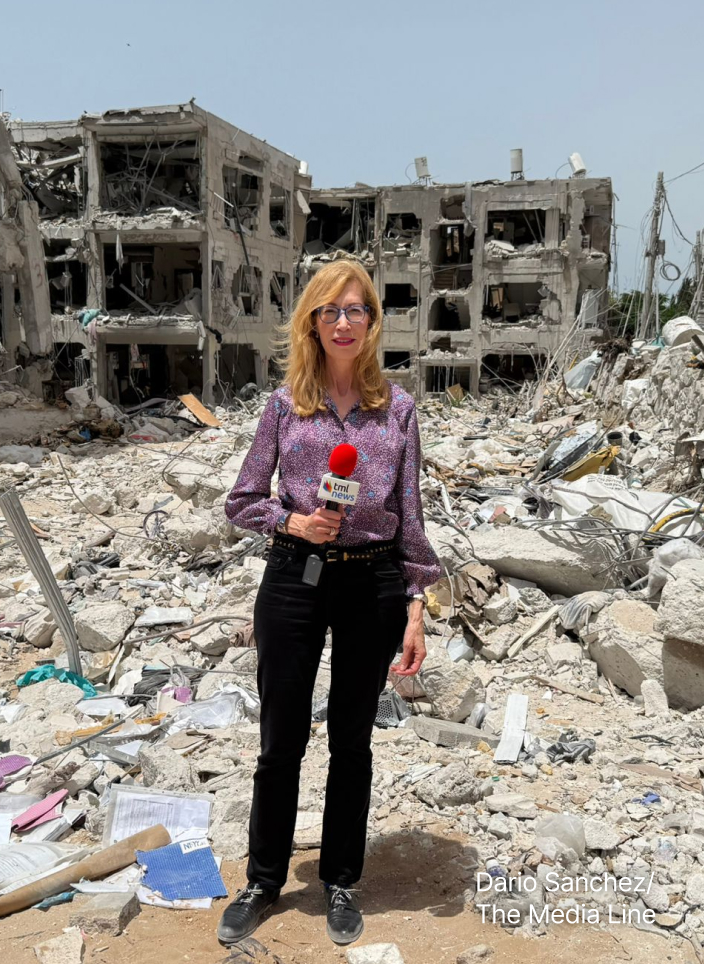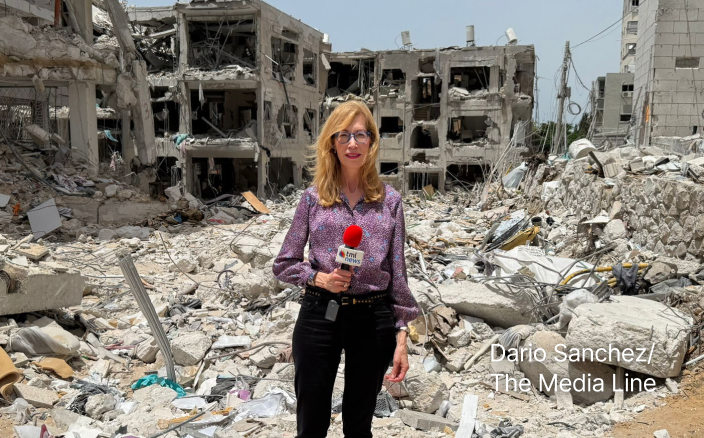Tehran’s recent anti-Israel activity may, somewhat counter-intuitively, be a sign of distress ahead of new American sanctions and as a regional alliance against it coalesces
The Gaza powder keg again was ignited this weekend as thousands of Palestinians converged on the security fence for Friday’s instalment of the so-called “March of Return” protests, which, as has been the case for six months, descended into mass chaos resulting in the deaths of at least four rioters. Then, beginning in the evening, sequential rocket salvos kept residents of southern Israel in bomb shelters for twelve hours while the army responded by striking scores of sites belonging to Hamas, and, more significantly, Islamic Jihad (IJ).
In fact, while the Israeli government ultimately holds Hamas responsible for all violence emanating from the territory it controls, the Israel Defense Forces nevertheless explicitly blamed the latter wholly owned Iranian subsidiary for launching the missiles, alleging that “orders and incentives were given from Damascus with a clear involvement of the Revolutionary Guards al-Quds force.” Late Saturday morning IJ unilaterally declared a cease-fire, a message conveyed to Jerusalem via Egyptian intermediaries already attempting to forge a long-term truce between Israel and Gaza’s rulers in order to avert a fourth major conflict in the past decade.
Accordingly, many analysts have attributed IJ’s aggressiveness to a desire on the part of Tehran—a master at fomenting and then harnessing instability to its geopolitical advantage—to torpedo these efforts. Notably, the move follows the transfer by Russia to the Assad regime of the advanced S-300 defense system, which has partially curbed Israel’s freedom of action to target Iranian military infrastructure in Syria. This all comes on the backdrop of reports that the Islamic Republic delivered sophisticated GPS components to Hizbullah that will enable it to transform inaccurate projectiles into precision-guided missiles, thereby increasing their threat to the Jewish state.
During a September speech to the United Nations General Assembly, Prime Minister Binyamin Netanyahu sounded the alarm over Hizbullah, revealing satellite imagery of three sites in Beirut where Iran’s underling allegedly has built underground manufacturing facilities to produce missiles capable of hitting within a few meters of practically anywhere in Israel. Last week, the IDF accused the Shiite terrorist group of operating a fake environmental NGO in order to illegally maintain a presence in the buffer zone separating Lebanon and Israel. Finally, Israeli media claimed Hizbullah is working to construct forward-operating bases in the Syrian Golan Heights just a few kilometers from the border with Israel, a development that, if true, casts serious doubt over Moscow’s purported guarantee to prevent the militarization of the frontier.
Give the gift of hope
We practice what we preach:
accurate, fearless journalism. But we can't do it alone.
- On the ground in Gaza, Syria, Israel, Egypt, Pakistan, and more
- Our program trained more than 100 journalists
- Calling out fake news and reporting real facts
- On the ground in Gaza, Syria, Israel, Egypt, Pakistan, and more
- Our program trained more than 100 journalists
- Calling out fake news and reporting real facts
Join us.
Support The Media Line. Save democracy.


Taken together, these circumstances suggest that Iran has become sufficiently emboldened to increase its proxy war against Israel. That said, while there are obvious acute concerns for Jerusalem, some observers are construing Tehran’s lashing out as evidence of the mullahs’ desperation amid civil unrest at home; ahead of the re-imposition of American sanctions on their country’s crucial oil sector; and as the United States-led alliance to counter the regime takes shape.
“As far as recent events go, the Iranians are like a cat in a corner and will try with whatever means they have in order to secure their continuity. They are facing daily mini-uprisings and they are very, very concerned,” Dr. Alireza Nourizadeh, Director of the London-based Center for Iranian and Arab Studies, explained to The Media Line.
“The upcoming measures in November are a nightmare for the Iranians as they are not 100 percent sure what President Trump will put on the table and how far he will go. Will there be a total ban on Iran’s oil exports, including [to such countries as] India, Japan and others? Everything is unclear and there are differences between the teams of President Hassan Rouhani and Supreme Leader Ayatollah Khamenei.
“In terms of what to watch for,” Dr. Nourizadeh imparted, “the Iranians are blocking the formation of [Lebanese Prime Minister] Saad Hariri’s cabinet, but if he is able to form one next week this could be a sign of compromise on [Riyadh’s part]. Also, Oman’s Sultan Qaboos [who in the past has acted as a conduit to the Iranian regime] hosted Prime Minister Netanyahu which also could be the start of a small rapprochement. Otherwise, I fear there will be very dark days to come.”
As regards Jerusalem, specifically, the government seems intent on leveraging its burgeoning diplomatic ties with the Sunni-Arab world in order to stymie Iran’s hegemonic ambitions. This would, by extension, at least for the time being reduce the probability of a conflagration along any one of three Israeli borders where the Islamic Republic has allied fighters stationed at the gates.
Indeed, Prime Minister Netanyahu on Friday made a public visit to Oman—the first by an Israeli leader to the Sunni Gulf nation in over two decades—after which Muscat called for the Jewish state’s regional integration irrespective of the amount of progress made towards achieving a peace deal with the Palestinians. Concurrently, Miri Regev became the first Israeli minister to pay an official visit to the United Arab Emirates, where an Israeli delegation is being permitted (as opposed to last year) to compete under its own flag in an international judo event. This, as U.S. President Donald Trump appears committed in the wake of the grisly murder of journalist Jamal Khashoggi to maintaining strong bilateral relations with Saudi Arabia, which along with Israel is a centerpiece of the White House’s foreign policy goal of rolling back Iran’s expansionism and potential nuclearization.
“The most important problem for Israel is [not Islamic Jihad in Gaza] but Iran’s military intervention in Syria,” Dr. Col. (ret.) Ephraim Kam, a Senior Research Fellow at the Tel Aviv-based Institute for National Security Studies, stressed to The Media Line. “Previously, the Israeli army had the advantage as its capabilities are superior to those of Iran, but this could change with the S-300 system [in Syrian hands]. The big question is how this will impact on the IDF’s [maneuverability] and everyone is waiting and see.”
That the Israeli military did not react to IJ’s attacks this weekend by targeting Iranian assets in Syria, coupled with the IDF’s reported lack of activity in that country since the downing last month by Syrian forces of a Russian reconnaissance plane, which the Kremlin nonetheless blamed on Jerusalem, is perhaps a telling indication of the emergence of a new, restrictive dynamic.
“With respect to Oman,” Dr. Kam continued, “Iran was almost certainly discussed but [Muscat] likely cannot help Israel much. On the other hand, The Trump administration’s approach is a big problem for the Iranians. He has backed out of the nuclear agreement, re-imposed financial penalties and has supported Israel [unequivocally] in its confrontations with the Islamic Republic. The regime does not understand the American leader and lacks an answer to his [unpredictability]. Accordingly, there is a chance Iran will be deterred moving forward.”
To paraphrase Orwell, then, Tehran’s strong maneuvering against Israel—including in Syria, Lebanon and, most recently, in the Gaza Strip—may, in reality, be a short-term manifestation of a rising fear of its prospective weakening.